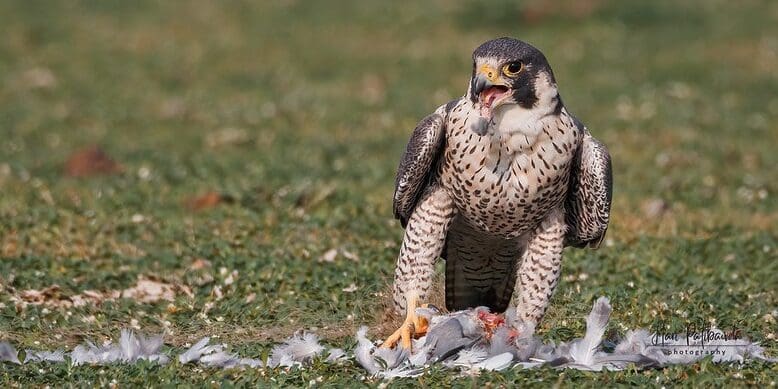Exploring new methods for using supplemental feeding
This blog was written by Dr Alison Greggor, Researcher in Conservation Science and Wildlife Health at the San Diego Zoo Wildlife Alliance.

It is common for conservation interventions to have pros and cons, which can vary depending on the context and how they are deployed. Providing supplemental food to animals after a conservation translocation is one such intervention. There is broad and clear evidence that supplemental feeding can improve survival; it can encourage animals to spend time near the release site where other management may be ongoing, and it can increase the likelihood and productivity of breeding [1,2]. However, supplemental feeding can also have drawbacks. There are documented cases of supplemental feeding hindering natural patterns of dispersal, influencing social interactions and acting as disease vectors [3,4]. Other hypothesized, but yet untested, impacts include increasing predation risk by making released animals more predictable. Meanwhile there are logistical drawbacks as well, since maintaining a network of feeders can be financially costly and they are ineffective if not sufficiently used by target animals.
As the use of translocations grows globally, getting the balance of pros and cons right for supplemental feeding is critical for increasing the efficacy of release efforts.
We explored whether some of the spatial drawbacks of feeding can be mitigated if feeding stations move on the landscape. Specifically, we wanted to know if we could direct animals’ use of space and habitat by moving feeders around. Being able to influence where released animals move has many potential applications for translocations, for example, by guiding them toward wild food resources or prospective territories, while directing them away from potential threats, such as predator hotspots or urban/agricultural centres. Such directed movement could also be useful for stimulating home range expansion or encouraging dispersal away from the release site to make room for future release cohorts and reduce competition.
Interventions rarely work equally across contexts, so we also explored whether there were any individual characteristics of released animals that make them more likely to use new supplemental feeding sites and whether the success of deploying supplemental feeders in new places varied by habitat features.

We tested these questions with a study [5] on recently released ‘alalā Corvus hawaiiensis, Hawai’i’s last living corvid species, that was extinct in the wild apart from the population we studied. They are omnivorous foragers, that historically occupied a range of dry and mesic habitats on Hawai’i Island, and coexisted with aerial predators. We strategically moved feeders varying distances, across both closed and open canopy habitats, while measuring how quickly birds discovered new feeders and how their space use changed. We conducted these movements in waves, returning the feeders back to their baseline locations before beginning moves into new areas. By doing so, we were able to tease apart changes in movement in response to the feeders from other seasonal or weather pattern changes that could occur over the course of the study.
We found that ‘alalā discovered feeders faster in closed as opposed to open canopy habitat, and that ‘alalā ranged farther when feeders moved away from baseline locations, especially in afternoon periods. Individual birds’ sex, social connectedness with other birds, and their home range size did not predict which birds would be fastest to discover new feeders, suggesting that the intervention need not be tailored to target a given type of bird.
These insights offer lessons for using supplemental feeding, post-release. Specifically, we identified a new tool for helping move translocated animals around, which could reduce some drawbacks of longer-term feeding. However, our results also suggest managers consider habitat features in choosing feeding locations. While we did not see any evidence of increased predation at open canopy feeders, the birds’ hesitancy to use those areas may have been due to greater visibility by predators, since we did not find any other differences in food resources between sites that would explain their slower arrivals.

These recommendations also come with caveats, since other species with differing levels of natural movement and exploration may not respond to feeder movement the same way, or may only respond to smaller distance movements. ‘Alalā easily found and used feeders at the farthest (150 m) movement we trialled. In other recently translocated bird species (e.g., white-shouldered fire-eye, Pyriglena leucoptera), birds did not disperse to new foraging patches beyond distances of 80–90 m [6], suggesting that some species have upper distance limits where feeder movement may not be effective. Future research exploring the use of this tool in other species would help with understanding its applicability and constraints.
While moving feeders around may seem like small management action, given the scale of a translocation, altering space use could have big impacts. The ‘alalā for instance historically moved seasonally in elevation to take advantage of changing resources. They also undergo a social transition when reaching adulthood, which makes them territorial and aggressive towards others. Being able to spread birds out on the landscape could therefore increase their use of seasonal food, and help minimize the potential for conspecific conflict.
As many translocation programs face issues with spatial behaviour, feeder movement could serve as a cost-effective method for directing movement and add an additional benefit to using supplemental food.
References
[1] Robb G.N. et al. (2008) Winter feeding of birds increases productivity in the subsequent breeding season. Biology Letters, 4, 220–223. https://doi.org/10.1098/rsbl.2007.0622
[2] White T.H. et al. (2012) Psittacine reintroductions: common denominators of success. Biological Conservation, 148, 106–115. https://doi.org/10.1016/j.biocon.2012.01.044
[3] Mertes K. et al. (2019) Management background and release conditions structure post-release movements in reintroduced ungulates. Frontiers in Ecology and Evolution, 7, 470. https://doi.org/10.3389/fevo.2019.00470
[4] Sorensen A. et al. (2014) Impacts of wildlife baiting and supplemental feeding on infectious disease transmission risk: a synthesis of knowledge. Preventive Veterinary Medicine, 113, 356–363. https://doi.org/10.1016/j.prevetmed.2013.11.010
[5] Greggor A.L. et al. (2024) The influence of feeding station location on the space use and behavior of reintroduced ’alalā: causes and consequences. Conservation Science and Practice, https://doi.org/10.1111/csp2.13077
[6] Awade M. et al. (2017) High emigration propensity and low mortality on transfer drives female-biased dispersal of Pyriglena leucoptera in fragmented landscapes. PLoS ONE, 12, e0170493. https://doi.org/10.1371/journal.pone.0170493



